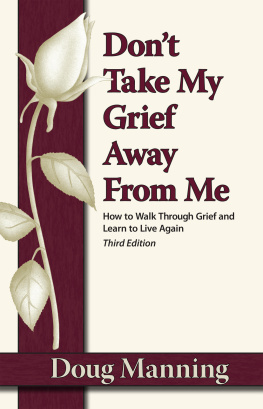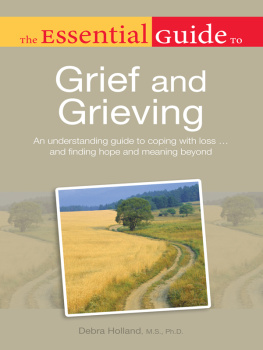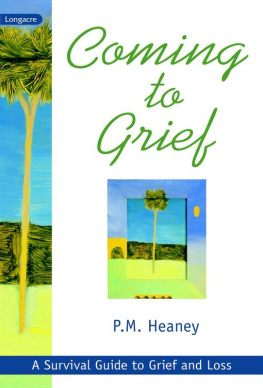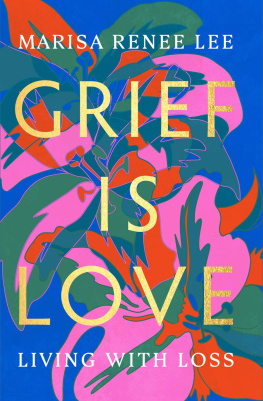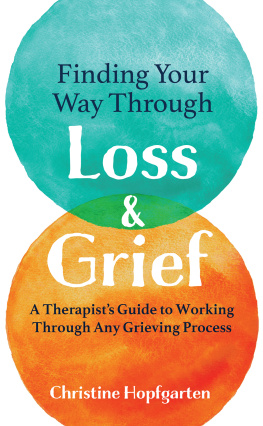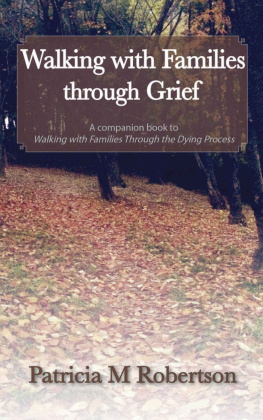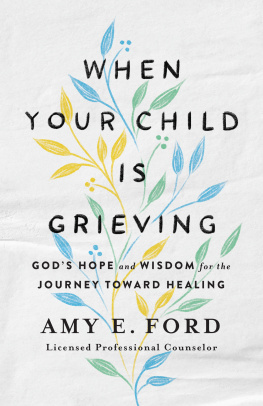Copyright 2015
InSight Books, Inc.
P.O. Box 42467
Oklahoma City, Oklahoma 73123
800.658.9262 or 405.810.9501
www.InSightBooks.com
All rights reserved. No part of this book may be reproduced in any form or by any means without prior written permission of the publisher, excepting brief quotes used in connection with reviews, written specifically for inclusion in a magazine or newspaper.
hard copy edition ISBN 978-1-892785-91-6
eBook edition ISBN 978-1-892785-92-3
Printed and bound in the United States of America
I had my own notion of grief
I thought it was the sad time
That followed the death of someone you love
And you had to push through it
To get to the other side
But Im learning that there is no other side
There is no pushing through
But rather
There is Absorption
Adjustment
Acceptance
And grief is not something you complete
But rather you endure
Grief is not a task to finish
And move on
But an element of yourself
An alteration of your being
A new way of seeing
A new definition of self.
Gwen Flowers
Written in honor of her babies: Skyler, Jordan, Hannah, Hope and Nicholas
Contents
WHAT DO I WEAR THE SECOND YEAR?
Grieving is a necessary passage and a difficult transition to finally letting go of sorrowit is not a permanent rest stop.
Dodinsky
There was a time when a widow was expected to wear black clothing for a year after her husband died. This showed her respect and love for him and alerted everyone that she was in grief. The problem with this practice waswhat happened when the year was over? There was nothing designed to let the world know that she was still in pain over the death. It was assumed that grief suddenly ended on the first anniversary of his death and she was thought to be back to normal. I can only imagine how glad she was to get rid of those black dresses. But, I can also imagine how many times she wanted to shout, But I still hurt! when the magic one year day arrived.
Almost every grieving person I have known has, at some time, said that the second year of their grief was harder than the first in some ways. Most have expressed surprise at that and have wondered why it was so. When I speak about grief beyond the first year, people are often shocked that there even needs to be a discussion about that. Somehow we have a built-in idea that grief lasts one year and then it is over.
This idea seems to be pervasive in our history. While a woman was wearing black, it was just understood that she was not to look at another man for that year. I cant find any such restrictions placed on the men of that day, but then women were the only ones allowed to grieve. Men were to be real men and suck it up and get on with their lives.
How Long?
Some religious practices through the centuries have developed very specific guidelines for the appropriate way to grieve and the timelines within which to grieve. The one-year idea might have come from the customs of grieving which have very specific and prescribed time frames and activities that are supposed to take place.
In the Jewish tradition, Aninut is the period from the moment of death until burial. The first week after the funeral is known as Shiva, the seven days of intense mourning. The next stage of the mourning process is known as Shloshim, a 30-day period from the day of the funeral. Shnat ha-evel, the first year of mourning, is reserved only for those who have lost parents during which the Kaddish is to be repeated daily. It is customary in some communities to keep the tombstone veiled, or to delay in putting it up, until the end of the 12-month mourning period.
In the Muslim faith the grieving period is identified as lasting for three days. For a woman whose spouse has died, she experiences the eddah, which lasts four months and 10 days.
In the Hindu tradition there are 13 days of official mourning.
Roman Catholics are expected to pray for and mourn their dead for a year.
So the basic message that grieving individuals receive from society, from history, from religious tradition, from common practice isgrieving is all over the map. The times set aside and the people for whom we are supposed to mourn varies widely.
Wherever the idea of the one-year period of mourning came from, the prevailing idea is that we should be well after one year and, when that doesnt happen, we are left wondering if there is something wrong with us. Since there is no standard for grief and everyone grieves in their own way and on their own schedule, we are all left wondering if we are doing it right. The second year is coming and we are still caught up in our loss which really brings on the self-doubt and fear that we are not doing our grieving in the right way.
The First Year: Grieving Interrupted
I really think that the more intentional and focused grieving, and most of the healing, happens after the first year. Somewhere toward the end of the first year is when most folks really begin facing the reality of their loss and begin to deal with the more specific losses. The first year we are so enmeshed in the pain and are just trying to survive. The grief comes in waves that overwhelm us and all we can do is shed tears and hurt. The capacity to think or respond is buried in the pain.
We are also far too busy in the first year. There are so many demands put upon us to take care of the business issues. Too many bills to pay, lawyers to visit, wills to be dealt with, and families to please, for there to be very much time for us to actually just grieve. We grieve on the run. We grieve in spurts between interruptions.
The first year forces us to deal with a seemingly endless number of firsts. The first holidays after the death, the first birthday, the first anniversary of marriage in the case of the death of a spouse. Endless first things missed after a child dies. And then comes the first anniversary of the death. All of these bring a new wave of pain and dominate our lives with a desperate struggle to survive. The pain, the waves of grief, the firsts, and the demands all make the grief journey one of starts and detours during the first days, weeks and months of the journey.
To add to this blur, we are numb. The mind protects itself from going crazy and just shuts down. It sounds like a contradiction, but we can hurt and be numb at the same time. The depression of grief does not exemplify itself with just sad feelings. It also brings no feelings. We feel detached as though we are outside of ourselves, watching us go through the motions of life, but not being emotionally involved ourselves.
This numbness makes it harder to actually deal with the intense part of grieving during the first year. As the feelings return, usually in the second year, we are often surprised at how much we still hurt and how many new hurts we discover.
All of these factors make it very hard to find the time or the emotional capacity to face all of the ramifications grief brings to our lives. It is unrealistic to think this can be done in one year or in any set period of time. As Yogi Bera said, It aint over til its over, and no one can put a time limit on how long it should take.


